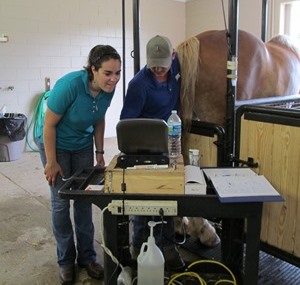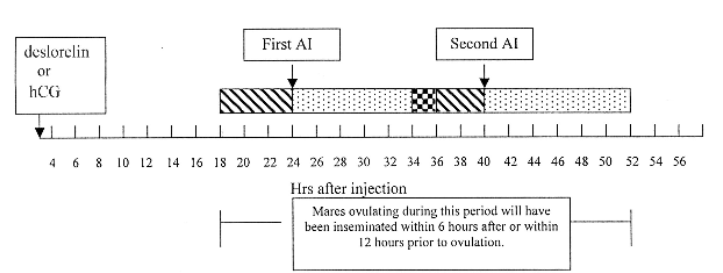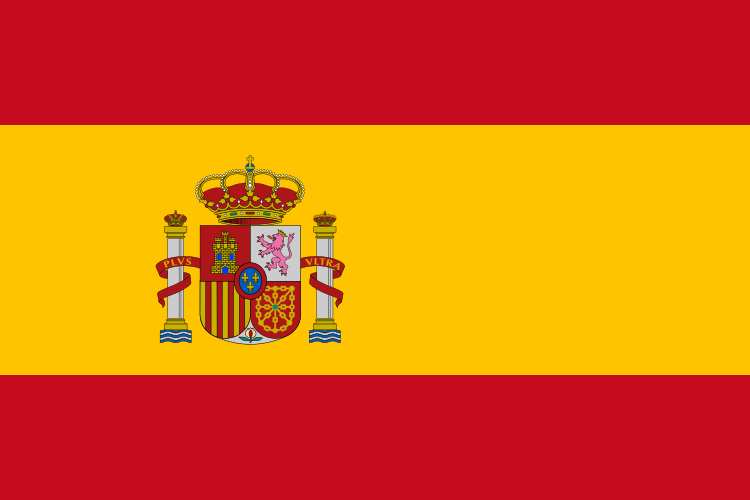 The use of the two-dose timed insemination protocol allows veterinarians the flexibility to examine mares once daily during normal hours without compromising fertility but while reducing management costs for the mare owner. This is the main reason why this protocol was developed by Dr. Sandro Barbacini of SBS Italia. Prior to developing this protocol most veterinarians would ultrasound mares every three to four hours in order to inseminate them with frozen semen as close to ovulation as possible. However, such a protocol is not only exhausting for the veterinarian but can also be a financial burden for the mare owner. In this article we will review the history of the two-dose timed insemination protocol, why it was developed, and discuss how it’s use can help with your breeding program.
The use of the two-dose timed insemination protocol allows veterinarians the flexibility to examine mares once daily during normal hours without compromising fertility but while reducing management costs for the mare owner. This is the main reason why this protocol was developed by Dr. Sandro Barbacini of SBS Italia. Prior to developing this protocol most veterinarians would ultrasound mares every three to four hours in order to inseminate them with frozen semen as close to ovulation as possible. However, such a protocol is not only exhausting for the veterinarian but can also be a financial burden for the mare owner. In this article we will review the history of the two-dose timed insemination protocol, why it was developed, and discuss how it’s use can help with your breeding program.
Why was the timed insemination protocol developed?
In 2000, Dr. Barbacini had a client who had recently sold their Appaloosa stallion. The sales agreement stipulated the previous owner could retain 10 breedings of frozen semen to breed their mares. At the time Dr. Barbacini preferred mares be housed at the SBS Italia facility when being bred with frozen semen so they could be monitored more closely for ovulation. However, the owner of these ten mares lived nearly 50 miles from SBS Italia and did not want to trailer them on a regular basis for ultrasounds nor leave them at another facility. So the owner asked Dr. Barbacini to develop a protocol which would allow the mares to remain at home but also efficiently use the frozen semen available.
Dr. Barbacini and his colleagues discussed possible protocols to determine which might work best for this situation. The protocol (see chart below) they developed involved a single daily examination of the mare until she had a 35mm pre-ovulatory follicle at which time hCG (2.000 IU IV) was administered. At 24 hours after the hCG was given, the mare was bred with the first dose of frozen semen and then 16 hours later she was bred with the second dose of frozen semen. All inseminations were performed by SBS Italia. It was expected that most mares would ovulate approximately 32-38 hours after administration of the ovulatory agent. By inseminating at 24 and 40 hours after hCG, the protocol would insure that viable sperm would be available for fertilization in the mare’s reproductive tract during the critical time of 12 hours before to 6 hours after ovulation for any mare ovulating between 18 and 52 hours after hCG.

Seven of the mares obtained a pregnancy on the first cycle, two mares became pregnant after two cycles and the final mare did not become pregnant due to reproductive issues. The protocol was deemed a success with this particular stallion. Thus, further research was warranted to determine if it was a viable option to implement industry wide.
Research
A few years later, Colorado State University (CSU) performed a study consisting of 40 cycles and two different treatments. The treatments consisted of 20 cycles each. For the first treatment, mares were bred with a full dose (800 million total sperm) of frozen semen post ovulation. As a result, 60% (12) of the mares became pregnant.
For the second treatment the mares were bred with half a dose (400 million total sperm) at 24 and another half dose (400 million total sperm) at 40 hours after hCG. Eleven (55%) of the mares obtained a pregnancy following this protocol. Therefore, no difference was shown between the two treatments. For additional information on splitting doses of frozen semen please see our article, Splitting Doses of Frozen Semen.

Over the next few years, SBS Italia then performed a clinical trial which included 170 cycles. For this trial mares were inseminated with one of 3 protocols.
- Group 1: Mares were bred one time during a cycle with one full dose (800 million sperm) of frozen semen.
- Group 2: Mares were was bred with two full doses (800 million sperm each) of frozen semen using the timed insemination protocol. One at 24 hrs and the second at 40 hrs after hCG.
- Group 3: Mares were bred with two half doses (400 million sperm each) of frozen semen using the timed insemination protocol. One at 24 hrs and the second at 40 hrs after hCG.
The results of this study show that using two doses of frozen semen, whether it be 400 or 800 million total sperm per insemination, results in higher pregnancy rates compared to inseminating the mare only one time (see chart below). You can find additional information on the difference of using one or two doses of frozen semen per cycle in our article, The Pros and Cons of 1 or 2 Dose Insemination Protocols.
Conclusion
In the past 16 years, the two-dose timed insemination protocol has become a tool which veterinarians utilize to not only allow themselves to get more sleep during breeding season but also to save their mare owners money. A few things to keep in mind when deciding if the timed insemination protocol is right for your situation is the status of the mare (see our article Influence of Mare Status When Breeding with Frozen Semen), the fertility of the frozen semen (It Only Takes One…Right?), and the number of doses available per cycle/contract (see our FAQ, What options do I have for buying frozen semen?).


Log in to join the conversation.